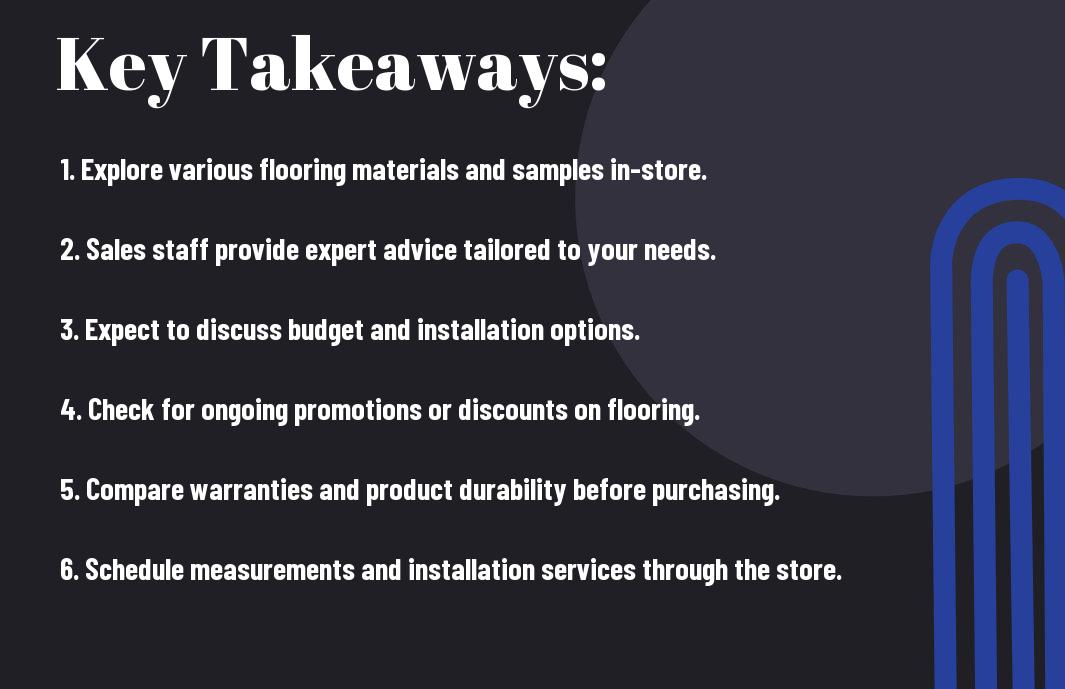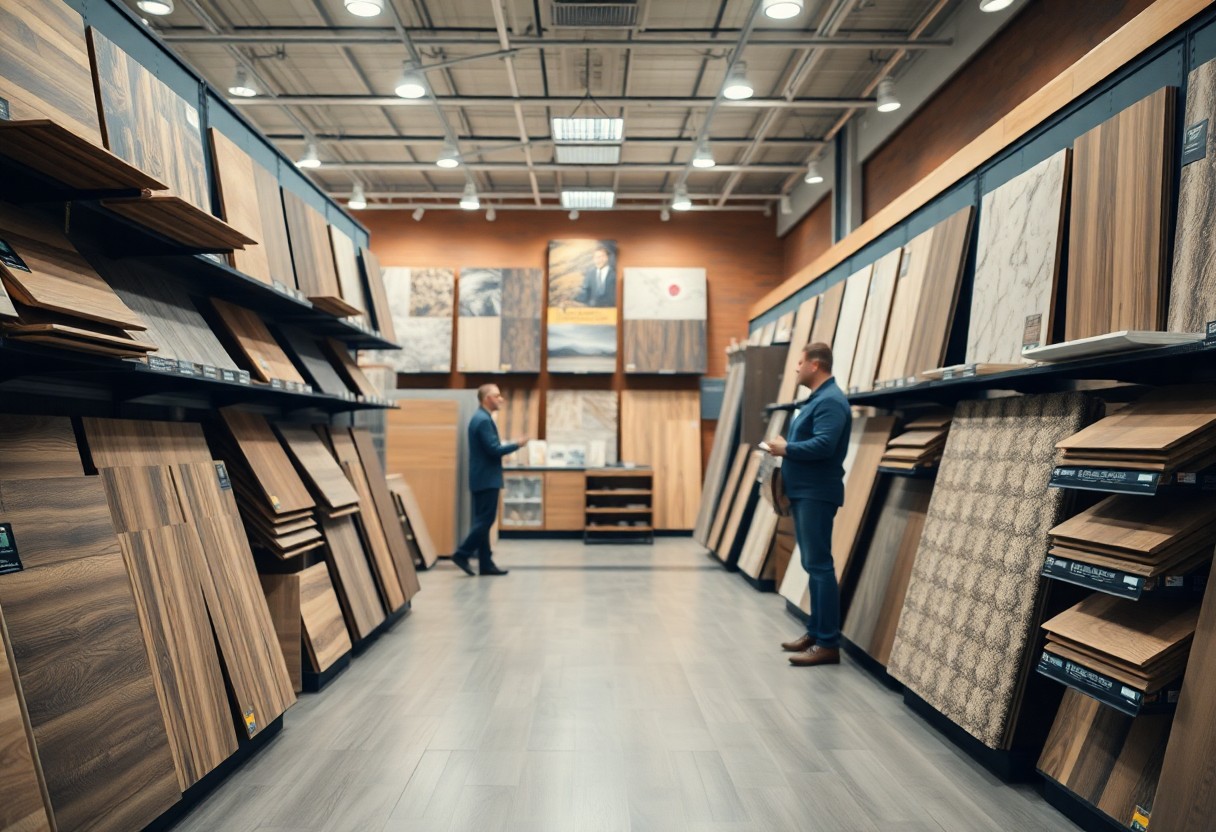Just stepping into a flooring store can be overwhelming, especially with so many options available. Understanding what to expect during your visit can simplify the process and help you make informed decisions. This guide offers insider insights that will prepare you for your shopping experience, from the types of flooring available to navigating sales approaches. Armed with this knowledge, you’ll be better equipped to choose the right flooring that suits your style and budget.
Understanding Different Flooring Options
The world of flooring is vast and filled with choices that can enhance the aesthetics and functionality of your space. With the right knowledge, you can confidently select the flooring that best fits your needs and style. This chapter will help you explore various materials and their attributes, ensuring you’re well-prepared to make an informed decision.
Types of Flooring Materials
- Hardwood
- Laminate
- Vinyl
- Tile
- Carpet
The wide variety of flooring options allows you to curate your home’s decor and optimize performance based on your lifestyle.
| Flooring Type | Description |
|---|---|
| Hardwood | A classic option loved for its beauty and warmth. |
| Laminate | Durable and affordable, mimics traditional wood. |
| Vinyl | Water-resistant, versatile, and easy to maintain. |
| Tile | Stylish, durable, great for moisture-prone areas. |
| Carpet | Soft and warm, ideal for cozy spaces. |
Pros and Cons of Each Material
An overview of the advantages and disadvantages of different flooring types can help you weigh your options effectively.
| Pros | Cons |
|---|---|
| Hardwood: Timeless appeal, increases home value. | Can be costly, sensitive to moisture. |
| Laminate: Budget-friendly, scratch-resistant. | Less durable than hardwood, can look fake. |
| Vinyl: Affordable, various styles, water-resistant. | Can be less visually appealing than natural materials. |
| Tile: Highly durable, great for wet areas. | Cold and hard underfoot, can crack. |
| Carpet: Soft comfort, noise reduction. | Stains easily, requires regular cleaning. |
Further exploration into the pros and cons of flooring materials can significantly influence your buying choice. By assessing factors like durability, maintenance, cost, and style, you can align your flooring selection with your practical needs and your aesthetic preferences. This attention to detail ensures that your investment supports your lifestyle and enhances your home’s overall appeal.

Key Factors to Consider When Shopping
Now that you’re ready to visit flooring stores, there are several key factors you should keep in mind to make the best decision:
- Your budget and pricing strategies
- Your style and aesthetic preferences
- The durability and maintenance needs of different materials
- The installation process and associated costs
Any informed decision will enhance your shopping experience.
Budget and Pricing Strategies
Against the backdrop of rising costs, it’s vital to establish a budget before you begin shopping for flooring. Factor in not just the price per square foot of materials, but also installation fees, underlayment, and potential maintenance costs. Having a well-defined budget will help narrow your options and prevent overspending.
Style and Aesthetic Preferences
Behind every flooring choice is your personal style and aesthetic preferences. Understanding what visual appeal resonates with you can significantly impact your satisfaction with your purchase.
Indeed, selecting flooring that mirrors your personal style is vital for creating a space that feels comfortable and inviting. Consider the colors, patterns, and textures that you enjoy, as these elements can transform a room. Whether you prefer the elegance of hardwood, the versatility of tile, or the cozy feel of carpet, make sure your flooring aligns with the overall design vision you have for your home. Engaging with flooring samples and visualizations can help you visualize how different styles will play out in your space.

The Importance of Measurement and Space Planning
After selecting the flooring material you desire, accurate measurement and space planning become your next steps. Properly evaluating the dimensions of your space ensures you purchase the right amount of flooring, minimizing waste and preventing costly mistakes. Understanding how your chosen flooring will fit into your home’s aesthetic and functionality is also important, leading to a more satisfying result once installed.
Measuring Your Space Accurately
Space measurement is key to a successful flooring project. You should take precise measurements of each room, including length, width, and any irregularities such as alcoves or recesses. Don’t forget to account for any fixtures, furniture, and doorways that may interfere with the layout, and always take multiple measurements to confirm accuracy.
Planning for Installation Logistics
About installation logistics, you need to consider factors such as the location of your flooring store, the delivery or pickup of materials, and scheduling your installation day. Coordination with any contractors or installers can also help streamline the process, ensuring everything goes smoothly from start to finish.
Even little aspects, such as ensuring there’s enough space for the installers to work and accessing the areas where flooring will be laid, should not be overlooked. Communicating with your installation team about any potential obstacles, like existing furniture or previous flooring that may need removal, will help alleviate stress on installation day. Being well-prepared can make a significant difference in the overall experience and outcome of your flooring project.
Shopping Tips for Navigating Flooring Stores
Despite the overwhelming options available, effective shopping at flooring stores can be streamlined with a few insightful tips:
- Research flooring types beforehand.
- Set a budget and stick to it.
- Bring samples of colors or materials from your home.
- Ask for discounts on excess inventory or clearance items.
Assume that staying organized and informed will empower you to make a confident decision.
Questions to Ask Sales Representatives
By engaging with sales representatives, you can uncover valuable insights about the flooring options you’re considering. Don’t hesitate to inquire about the warranty, maintenance requirements, and installation details for each product. You may also want to ask about the company’s reputation, customer service experiences, and any current promotions. Equipped with this knowledge, you can make a well-informed choice.
Recognizing Quality and Value
Behind every quality flooring option lies a combination of materials, workmanship, and longevity. Look for products that have strong wear ratings and come from reputable manufacturers. Pay attention to the design details as well; a well-constructed floor will exhibit consistent patterns, seamless edges, and durable finishes. Consider both aesthetics and practicality to ensure your flooring is not only beautiful but also stands the test of time.
Representatives can provide guidance on distinguishing high-quality materials from inferior ones. Inquire about the specifics of the flooring’s construction, such as the thickness of wear layers, core materials, and finishes. Test samples by walking on them to get a feel for their durability and comfort. Understanding these aspects will enable you to identify a product that delivers both quality and value for your investment.
The Role of Installation in Your Purchase
Not every flooring buy is complete without considering installation. The quality of your flooring can be overshadowed by poor installation, making it vital to understand how installation impacts the overall value of your purchase. Whether you’re investing in a high-end product or opting for a budget-friendly option, the right installation can enhance performance and longevity, ensuring your investment stands the test of time.
Choosing Professional Installation vs. DIY
At the outset of your flooring project, you’ll need to weigh the benefits of professional installation against the allure of DIY. Hiring experts ensures that the job is done efficiently and accurately, saving you time and potential headaches. On the other hand, if you possess the skills and confidence to handle it yourself, a DIY project can offer cost savings and a sense of accomplishment.
Understanding Installation Costs and Timelines
Choosing the right installation method involves more than just deciding on DIY or hiring professionals; it also requires a solid grasp of installation costs and timelines. Prices can vary widely based on the complexity of the project, materials used, and the installer’s rates. You should also factor in potential delays and scheduling, as your timeline may shift depending on availability and unforeseen challenges.
Installation can significantly affect the overall cost of your flooring project. When planning your budget, include expenses for labor, materials, and any additional prep work needed, such as subfloor repairs. Timelines can vary based on the type of flooring and the area being covered; some installations can take just a day, while others might take several days. Always communicate with your installer about expectations and plan accordingly to ensure a seamless finish.
Maintaining Your New Floors
All new floors require regular maintenance to keep them looking their best. By following manufacturer guidelines and implementing smart cleaning routines, you can ensure that your investment remains in excellent condition. Maintenance not only improves the appearance of your floors but also enhances their durability, allowing you to enjoy them for years to come.
Care Tips for Different Flooring Types
- Hardwood: Use a damp mop and avoid excess water.
- Laminates: Clean with a microfiber cloth and laminate cleaner.
- Tile: Sweep or vacuum regularly; use pH-neutral cleaners.
- Carpet: Vacuum frequently and schedule professional cleaning.
- Vinyl: Clean with mild soap and a soft mop; no abrasive tools.
Perceiving the needs of your flooring type will make maintaining it much easier.
| Flooring Type | Maintenance Tips |
| Hardwood | Keep it dry and use gentle products. |
| Laminates | Avoid soaking and use specialty cleaners. |
| Tile | Use non-abrasive cleaning solutions. |
| Carpet | Frequent vacuuming protects fibers. |
| Vinyl | Gentle cleaning preserves the surface. |
Ensuring Longevity Through Proper Maintenance
Types of maintenance practices you implement will significantly affect the longevity of your floors. Routine cleaning and addressing spills immediately will prevent damage and keep your floors looking new. Additionally, consider applying protective finishes or pads under heavy furniture to avoid scratches. Regular inspections can help identify potential issues before they become major problems. Investing a little time and effort now ensures you can fully enjoy your new floors without concern for premature wear.
The right maintenance routine is crucial for maximizing the lifespan of your flooring. By remaining proactive in your cleaning and care techniques, you guarantee a beautiful, functional living space for years to come.
To wrap up
With these considerations in mind, you can approach flooring stores with confidence, equipped with insights that will enhance your shopping experience. Understanding the different types of flooring, being aware of installation options, and knowing how to navigate pricing can empower you to make informed decisions. Take your time, ask questions, and compare products, ensuring that you find the perfect flooring solution that aligns with your style and budget. Shopping for flooring doesn’t have to be overwhelming; armed with the right knowledge, it can be a rewarding venture.

